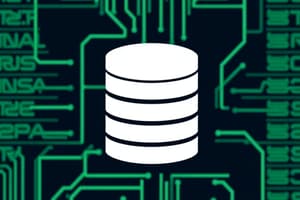Podcast
Questions and Answers
What primary function does a database management system (DBMS) serve in human resources?
What primary function does a database management system (DBMS) serve in human resources?
- To create web-based services
- To monitor production activities in factories
- To track inventory of items
- To manage employee data and payroll (correct)
Which DBMS was founded in 1995 and is considered one of the largest open-source companies?
Which DBMS was founded in 1995 and is considered one of the largest open-source companies?
- Oracle Database
- Microsoft SQL Server
- MySQL (correct)
- MS-Access
Which feature of a DBMS helps ensure that only authorized users can access the data?
Which feature of a DBMS helps ensure that only authorized users can access the data?
- Active processing
- Data querying
- Security measures (correct)
- Data visualization
What does the term 'mini-world' refer to in the context of a database?
What does the term 'mini-world' refer to in the context of a database?
Which relational database management system (RDBMS) is known for being developed by Oracle Corporation?
Which relational database management system (RDBMS) is known for being developed by Oracle Corporation?
Which task is NOT typically associated with the functionality of a DBMS?
Which task is NOT typically associated with the functionality of a DBMS?
What type of database is MS-Access most suitable for?
What type of database is MS-Access most suitable for?
What is a key characteristic of the Microsoft SQL Server?
What is a key characteristic of the Microsoft SQL Server?
What is the primary purpose of a Database Management System (DBMS)?
What is the primary purpose of a Database Management System (DBMS)?
Which of the following operations can a user perform on a database?
Which of the following operations can a user perform on a database?
In what application area are databases primarily used for storing customer accounts and transaction records?
In what application area are databases primarily used for storing customer accounts and transaction records?
How is data transformed into information in a computing context?
How is data transformed into information in a computing context?
Which statement about databases is correct?
Which statement about databases is correct?
Which of the following is NOT a function of a database system?
Which of the following is NOT a function of a database system?
What does the term 'repository' refer to in the context of a database?
What does the term 'repository' refer to in the context of a database?
Which of the following is an example of a typical application area for a DBMS?
Which of the following is an example of a typical application area for a DBMS?
What is the primary function of a DBMS catalog in a database system?
What is the primary function of a DBMS catalog in a database system?
Which relationship is correctly identified among mini-world entities?
Which relationship is correctly identified among mini-world entities?
What does program-data independence allow in a database management system?
What does program-data independence allow in a database management system?
What does data abstraction in a database system accomplish?
What does data abstraction in a database system accomplish?
What is a primary characteristic of multiuser transaction processing in a database?
What is a primary characteristic of multiuser transaction processing in a database?
Which of the following entities is NOT typically found in a university database?
Which of the following entities is NOT typically found in a university database?
What allows different users to see various views of the database?
What allows different users to see various views of the database?
Which statement best describes the self-describing nature of a database system?
Which statement best describes the self-describing nature of a database system?
Flashcards
Database
Database
A collection of related data sets organized for efficient access and management. Think of it as a structured storage for information.
Database Management System (DBMS)
Database Management System (DBMS)
A software system used to create, maintain, and manage databases. It provides tools for data storage, retrieval, and manipulation.
Database System
Database System
A complete system encompassing both the DBMS software and the actual data stored within it.
Data Transformation
Data Transformation
Signup and view all the flashcards
Data Manipulation
Data Manipulation
Signup and view all the flashcards
Data Retrieval
Data Retrieval
Signup and view all the flashcards
DBMS in Airlines
DBMS in Airlines
Signup and view all the flashcards
DBMS in Banking
DBMS in Banking
Signup and view all the flashcards
Self-describing Database
Self-describing Database
Signup and view all the flashcards
Program-Data Independence
Program-Data Independence
Signup and view all the flashcards
Data Abstraction
Data Abstraction
Signup and view all the flashcards
Multiple Views of Data
Multiple Views of Data
Signup and view all the flashcards
Data Sharing and Multiuser Processing
Data Sharing and Multiuser Processing
Signup and view all the flashcards
Concurrency Control
Concurrency Control
Signup and view all the flashcards
OLTP (Online Transaction Processing)
OLTP (Online Transaction Processing)
Signup and view all the flashcards
What is a Database Management System (DBMS)?
What is a Database Management System (DBMS)?
Signup and view all the flashcards
What is a database?
What is a database?
Signup and view all the flashcards
Database Definition
Database Definition
Signup and view all the flashcards
Database Construction or Load
Database Construction or Load
Signup and view all the flashcards
What is Database Manipulation?
What is Database Manipulation?
Signup and view all the flashcards
Concurrent Processing and Sharing in a DBMS
Concurrent Processing and Sharing in a DBMS
Signup and view all the flashcards
Protection or Security in a DBMS
Protection or Security in a DBMS
Signup and view all the flashcards
Active Processing in a DBMS
Active Processing in a DBMS
Signup and view all the flashcards
Study Notes
Introduction to Database Systems
- The field of computing translates information into a structured format, suitable for processing, recording, and storage by computer systems
- Data includes various forms like text, images, audio, etc.
- Information represents processed data in a meaningful way, such as "Student Information"
Agenda
- Basic Concepts, covering introduction to database systems
- Application Areas of DBMS, exploring uses of database management systems
- Examples of DBMSS, showcasing various database management systems
- DBMS Functionality, detailing the functions of database management systems
- Database Characteristics, highlighting key features of databases
Basic Concepts
- A database is an organized collection of related data items, enabling the user to view full or specific subsets as a single entity.
- A DBMS (Database Management System) is software designed for creating and maintaining databases.
- A Database System encompasses both the DBMS and the data itself.
Introduction to Database Systems
- Databases serve as repositories for computerised data, allowing users to perform operations.
- Operations include adding new data, inserting data into existing files, retrieving data, modifying data, deleting data, and removing database files.
Application Areas of DBMS
- Airlines: Managing reservations and schedules
- Banking: Handling customer information, accounts, and transactions
- Universities: Managing student details, course registrations, and grades
- Credit Card Transactions: Recording purchases and generating statements
- Telecommunications: Recording calls, generating bills, and managing accounts
- Sales: Managing customer, product, and sales data
- Manufacturing: Handling supply chain management, production tracking, and inventory
- Human Resources: Managing employee data, salaries, and benefits
- Web-based services: Collecting user feedback, and managing resources
Examples of DBMS
- MySQL: A widely used open-source DBMS known for efficiency and reliability.
- MS-Access: Microsoft's desktop-based DBMS, commonly used for personal and small-scale business applications.
- Oracle Database: A leading relational database management system, widely employed for large-scale data storage, particularly by major organizations.
- Microsoft SQL Server: A relational database management system developed by Microsoft, supporting various versions for MS-Windows, tailored to specific customer requirements.
DBMS Functionality
- Defining databases in terms of data types, structures, and constraints
- Constructing or loading databases onto secondary storage
- Manipulating database content (querying, reporting, insertions, deletions, modifications)
- Enabling concurrent processing and sharing by multiple users and programs, while preserving data validity and consistency.
- Implementing security measures to prevent unauthorized access.
- Actively processing data to perform internal actions.
- Presenting and visualizing data
University Database Example
- Mini-worlds are simplified representations of real-world data stored in a database.
- Entities relate to different aspects of a university, such as students, courses, and instructors.
- Relationships highlight connections between entities, depicting how students take courses, courses have prerequisites, or instructors teach courses within specific departments.
Library Loan Database Example
- The database manages borrowers, books, loans, and reservations.
- Relevant data includes borrower information, book details, loan dates, reservation details.
Database Characteristics
- Self-describing nature: Database systems have a built-in description of the data (meta-data) stored within the system.
- Program-data independence: Allowing changes in data storage structures and operations without affecting existing programs using the database.
- Data abstraction: Hiding storage details from users to present them with a simplified conceptual view.
- Multiple views of data: Providing differentiated views of the database for different users, restricting each view to display only relevant data for the respective user.
- Sharing of data and multiuser transaction processing: Allowing concurrent users to access and modify the data while preserving data integrity through concurrency control mechanisms.
- Online Transaction Processing (OLTP): A significant part of database applications, enabling real-time processing of transactions.
Studying That Suits You
Use AI to generate personalized quizzes and flashcards to suit your learning preferences.




